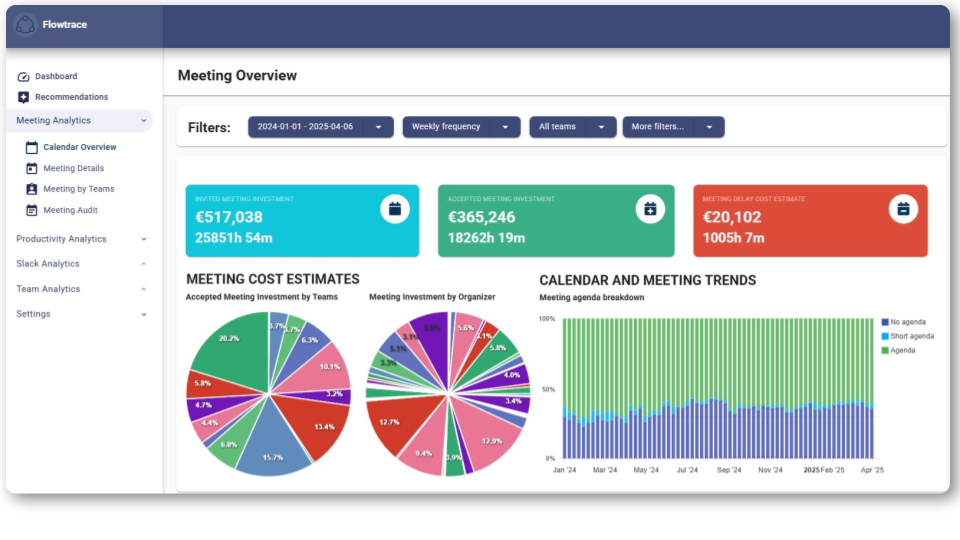Tips for Running Manufacturing Meetings
Optimize manufacturing meetings with structured practices and analytics to enhance productivity, safety, and operational efficiency. Learn practical...
Learn how to run effective hybrid meetings by adopting new practices and leveraging analytics to enhance collaboration and productivity across distributed teams.
Hybrid work is no longer a temporary experiment. For most organizations, it is the standard way of operating. Teams are split between offices and homes, often across time zones, yet many meeting habits remain rooted in the pre-pandemic world.
The result? Hybrid meetings that frustrate participants, overload calendars, and fail to deliver outcomes. Remote employees feel excluded, in-room attendees dominate, and leaders find themselves juggling back-to-back sessions with little time for focused work.
But hybrid meetings don’t have to be this way. When designed intentionally, they can become powerful tools for collaboration, decision-making, and alignment across distributed teams. The key is shifting away from old habits and embracing practices that respect time, encourage inclusivity, and use data to continuously improve.
This article explores why hybrid meetings are so challenging, the principles that underpin effective ones, practical steps organizations can take, and how analytics tools can help leaders transform meeting culture.
Hybrid meetings present unique difficulties that neither fully in-person nor fully remote meetings encounter. In fact, up to one-third of meetings are now considered unnecessary, intensifying calendar overload and frustration in hybrid environments.
Adding to the strain, inefficient meetings are cited as the number one barrier to productivity, with 68% of employees saying they lack sufficient uninterrupted focus time during the workday.

The challenges are not inevitable, they are a reflection of outdated practices in a new environment. To overcome them, organizations need a set of guiding principles.
Remote participants must be given the same opportunities to contribute as in-room colleagues. Side conversations or poor audio immediately create inequity.
Every hybrid meeting should have a clear agenda, expected outcomes, and documented follow-up. Drift and repetition are particularly damaging when teams are already fragmented across locations.
Hybrid should not mean 'more meetings.' Information-sharing and reporting should shift to asynchronous channels, with live sessions reserved for discussion and decision-making.
Organizations must treat meetings as a measurable process. Without analytics, leaders can’t see where time is lost or which recurring sessions are no longer valuable.
Effective hybrid meetings don’t happen by accident. They require policies, intentional design, and continuous review. Here are eight steps that organizations can adopt, each tied to the foundations of meeting culture Flowtrace helps analyze.

Without shared norms, every team runs meetings differently, leading to inconsistency and inefficiency. Hybrid organizations should establish policies such as:
Policies create consistency and accountability across distributed teams.
Recurring meetings are one of the biggest drivers of overload. Weekly stand-ups, status reviews, or cross-functional check-ins often continue out of habit.
Leaders should audit recurring sessions at least quarterly. Questions to ask include:
Meeting analytics often reveal that entire series of recurring meetings no longer add value but still consume hours across the organization.

Hybrid meetings run smoother when participants arrive prepared. By distributing agendas and pre-reads in advance:
This practice creates a balance between async preparation and synchronous action.
Not every interaction requires a meeting. In hybrid setups, shifting routine updates, project tracking, and document reviews into async channels creates enormous time savings.
Examples include:
Hybrid meetings should be reserved for collaboration that benefits from real-time dialogue.
Hybrid meetings are often bloated because of 'FOMO invites.' People attend to stay informed rather than contribute. This reduces efficiency and engagement.

Instead:
Hybrid meetings are particularly prone to overruns due to technology delays and dispersed teams. To maintain focus:
These steps respect participant energy and enable deeper work outside meetings.
Meetings without follow-up are one of the most common productivity killers. In hybrid environments, lack of documentation is even more damaging because not everyone shares the same context.
Best practices include:
.png?width=960&height=540&name=Marketing%20Images%20(8).png)
Even the best policies can falter without measurement. Hybrid organizations should track:
Data transforms meetings from habit-driven to evidence-driven, enabling leaders to refine practices continuously.
Effective hybrid meetings aren’t just a cultural benefit. They have measurable business impact:
In hybrid environments, where meetings often expand to compensate for lost visibility, these costs can grow even higher.
Even with best practices in place, most organizations lack visibility into how hybrid meetings actually impact performance. This is where analytics tools provide the missing insight.

By combining structured practices with analytics, organizations can transform hybrid meetings from a pain point into a competitive advantage.
Hybrid meetings should not be old habits transplanted onto Zoom or Teams. They require intentional design, cultural guardrails, and data-driven refinement.
By adopting policies, reviewing recurring sessions, balancing async with sync, managing time effectively, and leveraging analytics, organizations can turn hybrid meetings into moments of clarity and alignment rather than fatigue.
The future of hybrid work depends on making meetings more inclusive, productive, and purposeful. Organizations that get this right will not only save time but also strengthen collaboration and engagement across their workforce.
Agenda-or-cancel, timeboxing, action item documentation, and defined outcomes are essential policies that create consistency across hybrid teams.
At least quarterly. Leaders should cancel, shorten, or move recurring meetings to async channels if they no longer deliver value.
By shifting status updates, document reviews, and reporting to async platforms, freeing hybrid meetings for dialogue, brainstorming, and decision-making.
Key metrics include meeting hours per employee, meeting cost, participation levels, and employee ratings of usefulness.
By providing calendar analytics, cost visibility, participation insights, and feedback loops that help leaders measure, analyze, and continuously improve hybrid meeting practices.
Optimize manufacturing meetings with structured practices and analytics to enhance productivity, safety, and operational efficiency. Learn practical...
Discover why meeting overload happens and how to combat it for a more productive and engaged workplace.
Discover the 10 common signs of bad meetings and learn actionable strategies to transform them into productive and efficient sessions for your...